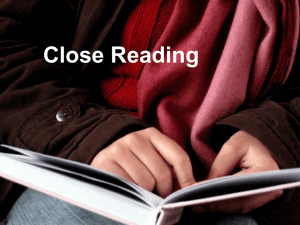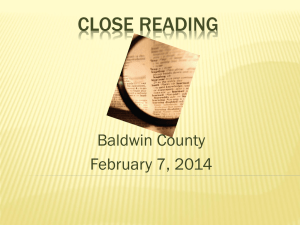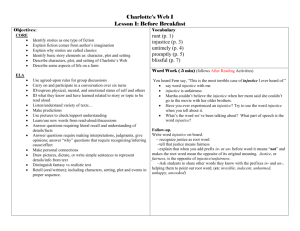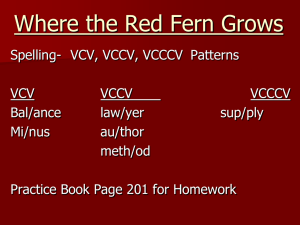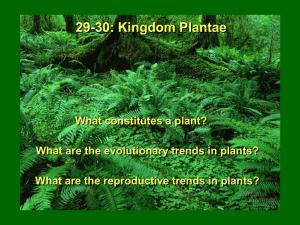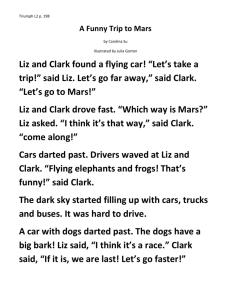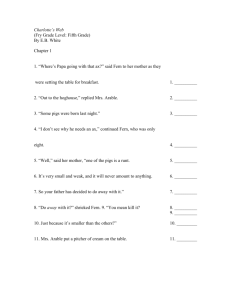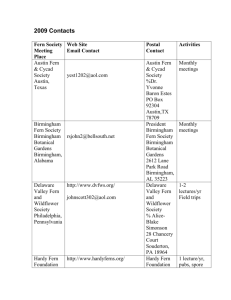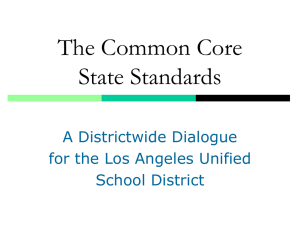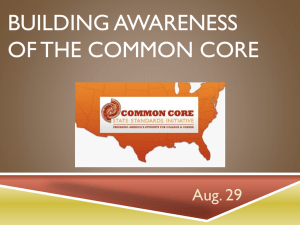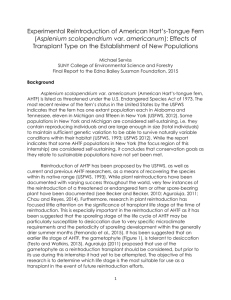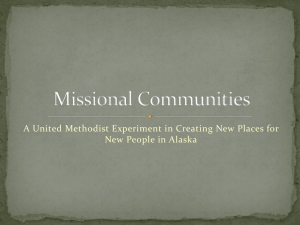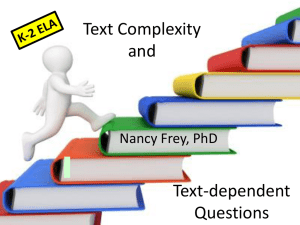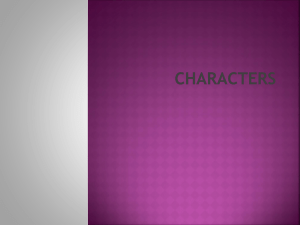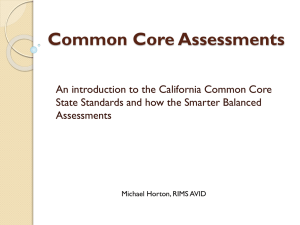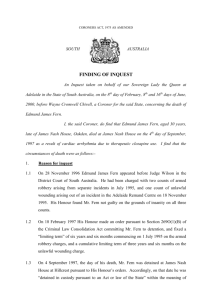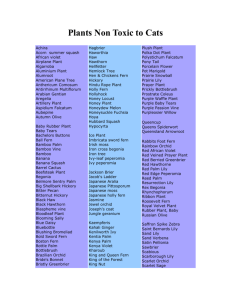Close Reading PowerPoint
advertisement
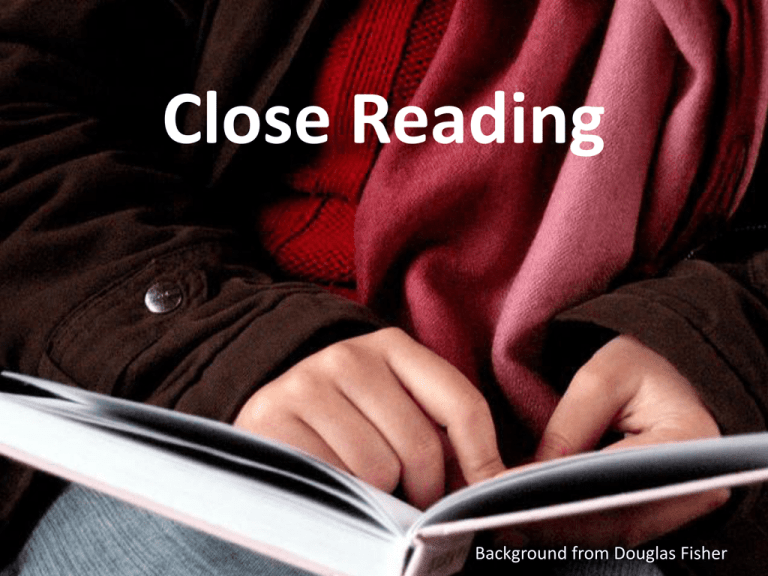
Close Reading Background from Douglas Fisher Our Ongoing Goal • To ensure all students are career and college ready Background from Douglas Fisher Connections to the AWSP Framework • Creating a Culture – 1.1 Develops and sustains focus on a shared mission and clear vision for improvement of learning and teaching. – 1.2 Engages in essential conversations for ongoing improvement. • Aligning Curriculum – 4.2 Alignment of best instructional practices to state and district learning goals. • Improving Instruction – 5.3 Assists staff in implementing effective instruction and assessment practices. Where We’ve Been • Administrators: – Introduction to Common Core State Standards – Understanding the Structure of the ELA document – Vertical Articulation of the ELA Standards Where We’ve Been • Literacy Committee(K-12 Teachers) Examined: – – – – – – – – Argumentative Writing Narrative Writing Explanatory/Informative Writing SBAC Assessment Claims Reading/Writing Integration Possibilities Speaking and Listening Text Complexity Close Reading Where We’ve Been • CAT2 ELA Group (K-12 Teaches) Examined: – Argumentative Writing – – – – – – Narrative Writing Explanatory/Informative Writing SBAC Assessment Claims Reading/Writing Integration Possibilities Speaking and Listening Text Complexity Where We’ve Been • High School CTE Teachers – Understanding the structure of the document – Revising CTE unit plans to include CCSS goals Where We’ve Been • District Librarians – Text Complexity – Knowledge in the Disciplines (Content Reading) – Distribution of Texts Where We’ve Been Summer Institutes • Unpacking the CCSS (summer 2012) • Creating CCSS aligned units (Summer 2013) – – – – – – Understanding by Design Teacher Checklist Correlate current ELD Standards into unit design Student Checklist Student Rubric Performance task creation (Summative Assessment) Today’s Goal •Engage staff in collegial conversations regarding close reading •Identify the components of close reading and make connections to current literacy practices •Evaluate a close reading lesson Close Reading is not… Andrea and Gilberto passed an ice cream shop every day when they walked home from school. Every Friday they brought money to _______ and stopped at the ice cream _________ to buy a double-dip ice cream ___________. One ________ Gilberto forgot to bring ________ money and when they got to __________ ice cream shop, he said, “Oh no. I can’t buy an ice cream _________ today.” Close Reading is…. “Close Reading – an intensive analysis of a text in order to come to terms with what it says, how it says it, and what it means.” Tim Shanahan Close Reading is…. “Focused, sustained reading and rereading of a text for the purpose of understanding key points, gathering evidence, and building knowledge. Pearson, page 48 Primary Purpose of Close Reading The primary objective of a close reading is to afford students with the opportunity to assimilate new textual information with their existing background knowledge and prior experiences to expand their schema. Doug Fisher Secondary Purpose of Close Reading A second purpose of a close reading is to build the necessary habits of readers when they engage with a complex piece of text. Doug Fisher Anchor Standard 9 Anchor Standard 8 Anchor Standard 7 Anchor Standard 6 Anchor Standard 5 Anchor Standard 4 Anchor Standard 3 Anchor Standard 2 How To Do A Close Read • Read with a pencil in hand – annotate the text • Look for patterns in the things you’ve noticed about the text – repetitions, contradictions, similarities – This is whatever the teacher wants the students to look for: key ideas & details, central message or theme, character traits, etc • Ask questions about the patterns you’ve noticed – especially how and why Annotation is a note of any form made while reading text. “Reading with a pencil.” Annotation slows down the reader in order to deepen understanding. People have been annotating texts since there have been texts to annotate. Annotation is not highlighting. Close Reading of Charlotte’s Web CCSS Standards: We are Learning To… • Ask and answer questions about our reading by using the text to support our answers (RL.3.1) • Recount stories to determine theme (RL. 3.2) • Determine the meaning of words and phrases in a story (RL. 3.4) Language Objectives: We are Learning To…. Use sketches, words, phrases, simple or descriptive sentences to represent the sequence of the story (R. 2.2.1 and 2.2.3) Use words, phrases, simple or descriptive sentences and specialized vocabulary to draw conclusions supported from text (R.2.4.1) Close Reading of Charlotte’s Web Read Charlotte’s Web Chapter 1 to get the flow and general understanding of the story. Read with a pencil to annotate the text (Underline and number key events/ words/phrases) Accountable Talk For classroom talk to promote learning it must be accountable: to the learning community, to accurate and appropriate knowledge, and to rigorous thinking. --University of Pittsburgh Source Handbook Work with a partner at your table to recount what has taken place in the story so far? Be sure to use/cite specific textual evidence in your answer. Literal—Beginning This is a story about a little girl. Fern, who lives on a farm with her mother, father, and brother. First, Fern’s father, Mr. Arable, sets out with an ax. Second, Fern asks, “Where’s papa going with that ax?” Next, Fern learns her father is going to kill a piglet because it is a runt and, as he says, “A weakling makes trouble.” Later, Fern calls this event a terrible injustice. Finally, she persuades her father to give her the piglet. Literal—Advanced This is a story about a little girl. Fern, who lives on a farm with her mother, father, and brother. The story begins with Fern’s father, Mr. Arable setting out with an ax. Fern gets concerned and asks, “Where’s papa going with that ax?” Afterward, Fern learns her father is going to kill a piglet because it is a runt and, as he says, “A weakling makes trouble.” Thereupon, Fern calls this event a terrible injustice. After a short time, she persuades her father to give her the piglet instead. Reread Look for key details that might help you determine a central message or theme beginning to emerge. Accountable Talk Invite your partner to give some examples from the text as evidence. Say to each other, “What in the story makes you say that?” to propel the conversation. Turn to your “elbow partner” and answer the following question: 1. What’s the story beginning to be about? 2. Be sure to include details from the story. Did your conversation look like this? (beginning) The story is starting to be about a struggle for justice. Fern says “It’s unfair” a couple of times. She also says it’s the most terrible case of injustice she’s ever heard of. Fern tries to wrestle the ax from her father’s hand. Did your conversation look like this? (advanced) The story explores a struggle for justice. This struggle is illustrated when Fern says “It’s unfair” a couple of times and she declares it’s the most terrible case of injustice she’s ever heard of. This struggle climaxes when Fern tries to wrestle the ax from her father’s hand. Reread • Some words matter more than others. Analyze E.B. White’s word choice. Which words call your attention? The family’s last name is Arable. The main character’s name is Fern. Her father’s name is John. “The kitchen table was set for breakfast, and the room smelled of coffee, bacon, and wood smoke from the stove.” “Mr. Arable set the carton down at Fern’s place. Then he walked to the sink and washed his hands and dried them on the roller towel.” “There, inside, looking up at her, was the newborn pig. It was a white one. The morning light shone through its ears, turning them pink.” CCR Anchor Standard 1 "Read closely to determine what the text says explicitly and to make logical inferences from it; cite specific textual evidence when writing or speaking to support conclusions drawn from the text.“ CCR Anchor Standard 2 “Determine central ideas or themes of a text and analyze their development; summarize the key supporting details and ideas. CCR Anchor Standard 4 “Interpret words and phrases as they are used in a text, including determining technical, and figurative meanings, and analyze how specific word choices shape meaning or tone. Student’s annotation of connotative meanings in Charlotte’s Web Even young students can annotate. Annotation in PreK-2 • Language experience approach • Interactive writing and shared pen activities 5 Modeled Annotation in Kindergarten Kemp, L. M. (1996). One peaceful pond: A counting book. New York: Houghton Mifflin. Modeled Annotation in Second Harvey, S., & Goudvis, A. (2007). Strategies That Work: Teaching Comprehension for Understanding and Engagement. Portland, ME: Stenhouse. Using Questioning in Fifth Grade Same text, different student, different strategy: Inferring. Modeled annotation in Seventh Grade Modeling in 9th Grade English Student annotation in 11th grade English If you want to teach effective annotation, begin with the purpose. “X-ray the book” Douglas Fisher Break Accountable Talk Review “Close reading must be accompanied by other essential instructional practices that are vital to reading development: interactive readalouds and shared readings, teacher modeling and thinkalouds.” --Douglas Fisher Unwelcome Change Unwelcome Change Lyrics © 2005 by Becky Thomas Classroom Educational Use Only Ochoa Middle School, Pasco School District Tune: "Amazing Grace " Listen to : "Amazing Grace" There was a time when life was good, When I could be just me. I played outside and with my friends, My life was safe and free. But then one day my whole world changed. The soldiers stormed our streets. Their boots and yells disturbed our peace And precious dignity. New rules and laws, a curfew tells What time to be at home. The stars must show upon our arms To keep us all alone. They forced us from our own sweet homes. We had to leave our things, And move into a small ghetto Fenced in, no longer free. The soldiers came to call one day, It now was time to go Aboard the waiting cattle cars Our fate I did not know… Close Reading In a CCSS-aligned 5th grade classroom, students will read speeches made by Patriots, look at propaganda on the part of Loyalists and Patriots, weigh the reasons people took sides in that war, and imagine themselves in the shoes of people who hold different views on this topic INSTEAD of simply reading a summary of the American Revolution. Background from Douglas Fisher Make Instructional Connections Close Reading supports PSD’s Content and Instructional Approaches GLAD • Learning Log • Process Grid • Chants • Poems • Timelines • Heads Together • Sentence Frames • Picture File Cards • Positive Interdependence Balanced Literacy • Independent Reading • Reading Conference • Informal Assessment • Read Aloud • Shared Reading • Literacy Squared Lotta Lara • Annotations • PreWriting Process • Note Collection • Speaking and Listening • Text Specific discussions • Text Dependent Questions & Tasks Content • History • Math • Science • Reading • Writing • Music • Art Bonus Analyze Close Reading Lesson Use TPEP Framework to analyze this lesson Notice and Note Resources A final thought…. “If young readers do the work of the first three anchor standards well— comprehending, inferring, synthesizing —then they’ll move rapidly up levels to the kinds of stories where paying attention to craft, structure, and language will become an essential part of their everyday reading work.” -Calkins, Ehrenworth, & Lehman, 2012
